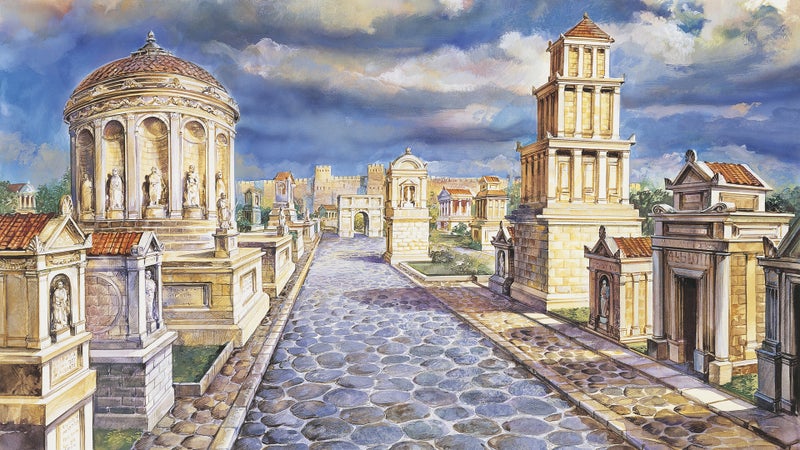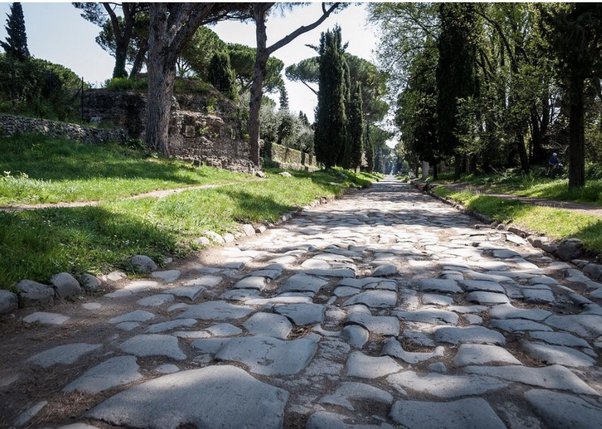The first major Roman road, famed Appian Way (Queen of Roads) was constructed in 312 BC to serve supply route between republican Rome and its allies in Capua during 2nd Samnite War. From then on, road systems often sprang from Roman conquest.

As legions blazed a trail through Europe, Romans built new highways to link captured cities with Rome and establish them as colonies. These routes ensured that Roman military could out-pace and out-maneuver its enemies, but they also aided in everyday maintenance of Empire. Reduced travel time and marching fatigue allowed fleet-footed legions to move as quickly as 20 miles a day to respond to outside threats and internal uprisings. Even most isolated parts of Roman world could expect to be swiftly supplied or reinforced in the event of an emergency, lessening need for large and costly garrison units at frontier outposts.
Since Roman roads were designed with speed of travel in mind, they often followed remarkably straight trail across countryside. Land surveyors or gromatici, began building process by using sighting poles to painstakingly chart most direct route from one destination to another. Resulting roads often shot straight up steep hills and small bridges and tunnels were built to ensure path could traverse rivers or pass right through mountains. Even in instances where road was forced to divert from its course, Romans typically opted for sharp turns and switchbacks over sweeping curves to preserve their arrow-straight design. Britain’s Fosse Way, for example, only veered a few miles off course over its entire 180-mile distance.

Roman builders used whatever materials were at hand to construct their roads, but their design always employed multiple layers for durability and flatness. Crews began by digging shallow, 3ft trenches and erecting small retaining walls along either side of the proposed route. Bottom section of road was usually made of leveled earth and mortar or sand topped with small stones. This was followed by foundation layers of crushed rocks or gravel cemented with lime mortar. Finally, surface layer was constructed using neatly arranged blocks made from gravel, pebbles, iron ore or hardened volcanic lava. Roads were built with crown and adjacent ditches to ensure easy water drainage and in some rainy regions they were even nestled on raised berms known as “aggers” to prevent flooding.

As made their way down one of Rome’s many roadways, weary travelers could guide themselves by detailed collection of mile markers. Much like the road signs on modern interstates and freeways, these stone pillars gave distance to nearest town in Roman miles and instructed traveler on best places to stop. They also provided information on when the road was built, who constructed it and who last repaired it. To embody idea that “all roads lead to Rome,” Emperor Augustus even saw that so-called “golden milestone” was placed in Roman Forum. Cast from gilded bronze, this monument listed the distance to all city’s gates and was considered convergence point of Empire’s road system.
Along with road signs and mile markers, Roman roads were also lined with state-run hotels and way stations. Most common of these ancient rest stops were horse changing stations or “mutationes,” which were located every 10 miles along most routes. These simple posthouses consisted of stables where government travelers could trade their winded horse or donkey for a fresh mount. Switching horses was especially important for imperial couriers, who were tasked with carrying communications and tax revenues around Empire at breakneck speed. By stopping off at multiple posthouses, couriers could move as far as 60 miles in single day. Along with more common mutationes, travelers could also expect to encounter roadside hotels or “mansiones,” roughly every 20 miles. Each “mansio” offered basic lodgings for people and their animals as well as place to eat, bathe, repair wagons or even hire a prostitute.
#archaeohistories





